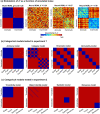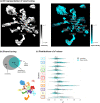Sensitivity and specificity of the action observation network to kinematics, target object, and gesture meaning
- PMID: 39037079
- PMCID: PMC11261593
- DOI: 10.1002/hbm.26762
Sensitivity and specificity of the action observation network to kinematics, target object, and gesture meaning
Abstract
Hierarchical models have been proposed to explain how the brain encodes actions, whereby different areas represent different features, such as gesture kinematics, target object, action goal, and meaning. The visual processing of action-related information is distributed over a well-known network of brain regions spanning separate anatomical areas, attuned to specific stimulus properties, and referred to as action observation network (AON). To determine the brain organization of these features, we measured representational geometries during the observation of a large set of transitive and intransitive gestures in two independent functional magnetic resonance imaging experiments. We provided evidence for a partial dissociation between kinematics, object characteristics, and action meaning in the occipito-parietal, ventro-temporal, and lateral occipito-temporal cortex, respectively. Importantly, most of the AON showed low specificity to all the explored features, and representational spaces sharing similar information content were spread across the cortex without being anatomically adjacent. Overall, our results support the notion that the AON relies on overlapping and distributed coding and may act as a unique representational space instead of mapping features in a modular and segregated manner.
Keywords: action observation network; action representation; d prime; fMRI; representational similarity analysis.
© 2024 The Author(s). Human Brain Mapping published by Wiley Periodicals LLC.
Conflict of interest statement
The authors declare no conflicts of interest.
Figures






References
-
- Avants, B. B. , Tustison, N. , & Song, G. (2009). Advanced normalisation tools (ANTS). Insight Journal, 2(365), 1–35.
-
- Baldauf, D. , & Desimone, R. (2014). Neural mechanisms of object‐based attention. Science, 344(6182), 424–427. - PubMed
-
- Benjamini, Y. , & Yekutieli, D. (2001). The control of the false discovery rate in multiple testing under dependency. Annals of Statistics, 29, 1165–1188.
MeSH terms
Grants and funding
LinkOut - more resources
Full Text Sources
Medical

